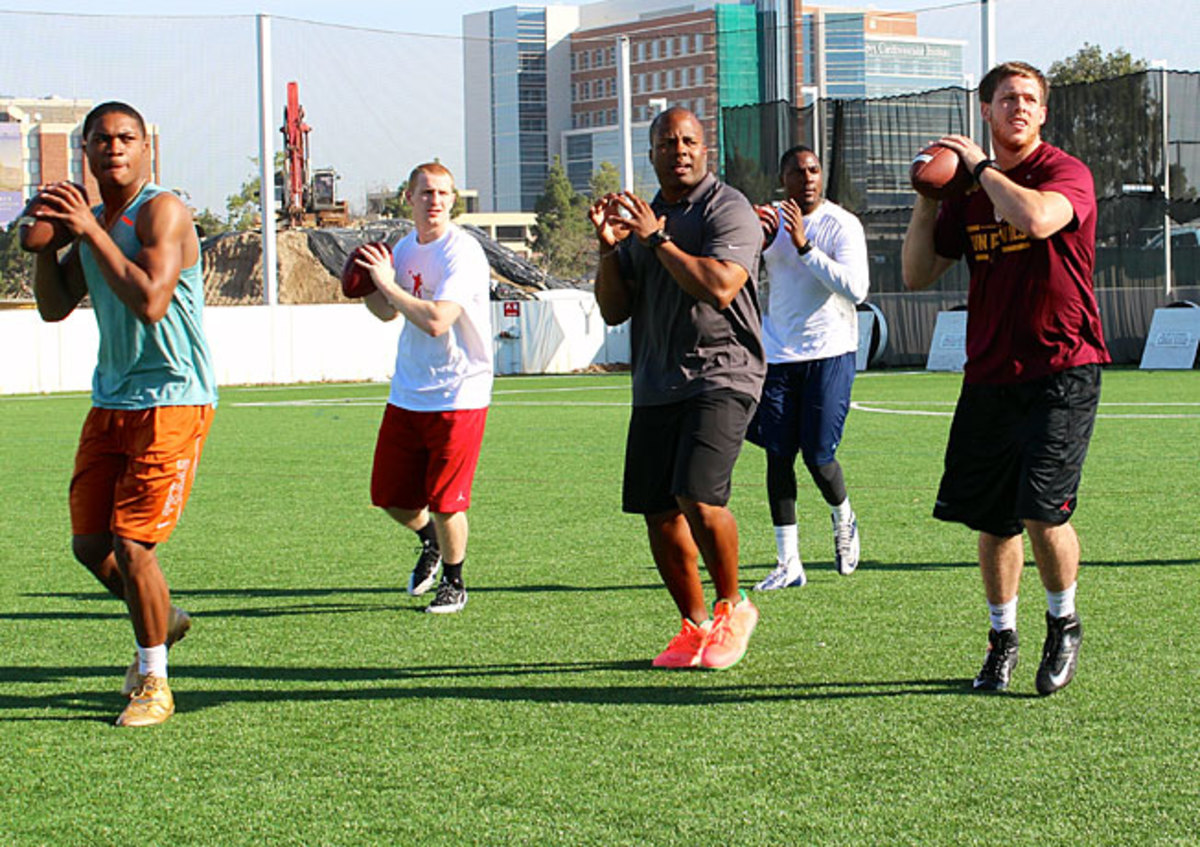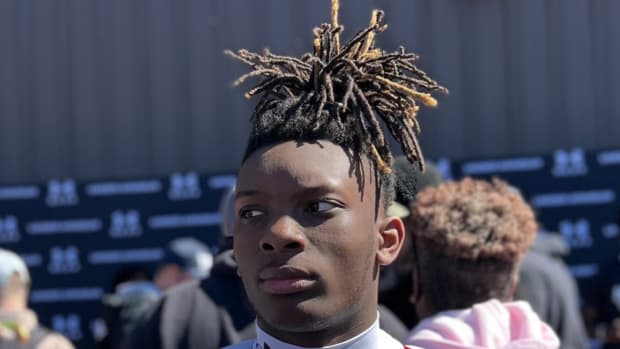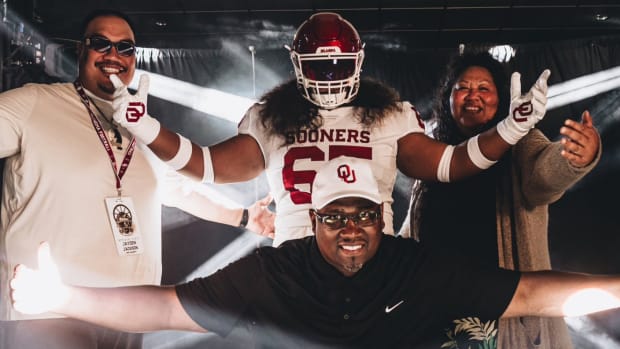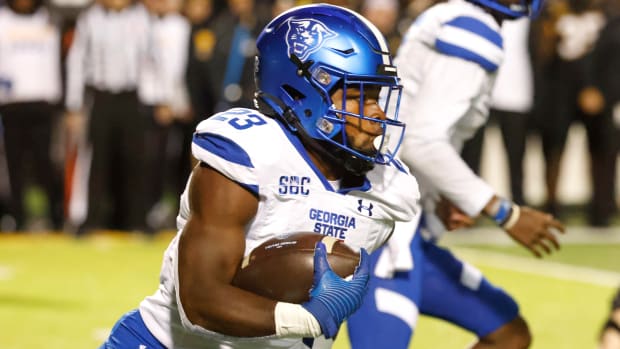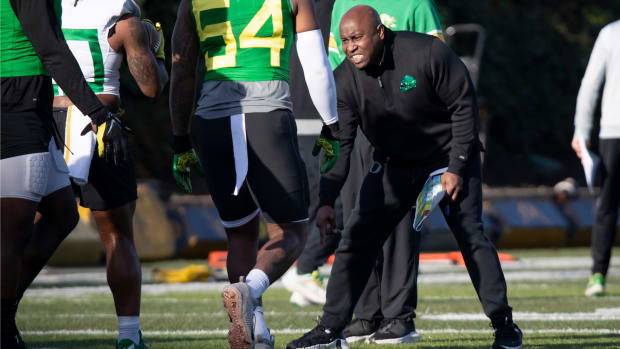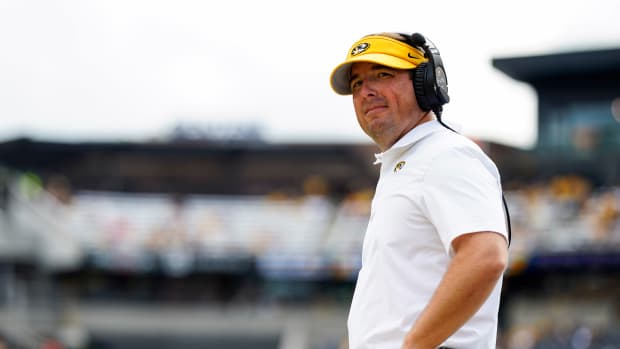An inside look at George Whitfield's spring break QB camp
SAN DIEGO — On the morning of March 10—the Monday of their spring break—while many of their classmates (and maybe some of their teammates) were sleeping off the previous night's party, a group of college quarterbacks sat in a semicircle and lobbed questions at a guy with a proven quarterbacking and partying track record. Johnny Manziel had just arrived to resume his training for a pro day at Texas A&M on March 27. He is where those 13 quarterbacks want to be, so they wanted to know how to get there.
Virginia quarterback David Watford wanted to know the biggest change Manziel made in the 2012 offseason that helped him with the starting job in College Station. Manziel explained that he learned to keep his left elbow tucked during his delivery, which cured a number of mechanical issues. It also provided Johnny Football with something he lacked in spring practice that year. "I just needed confidence," Manziel told the quarterbacks.
Every player who had given up his vacation for this week of quarterback boot camp needed something different. Back in Charlottesville, Watford is locked in a competition with Greyson Lambert to win the starting job that Watford held for all of last season. Watford wanted to learn to engage his lower body more and stop relying entirely on his DC Comics-like upper body—the man will never be able to buy a suit off the rack—to power the ball to his receivers. Meanwhile, North Carolina's Marquise Williams wanted an overall mechanical assessment that would help him target individual issues between now and the start of a promising season in which he will likely take over for departed starter Bryn Renner. Bryce Petty, the starter at defending Big 12 champ Baylor and a potential Heisman Trophy contender, wanted a refresher course to ensure that he keeps making progress. So did Taylor Kelly, the incumbent Arizona State quarterback who led the Sun Devils to the Pac-12 South title last season. Incoming freshmen Jerrod Heard (Texas) and David Morrison (Ball State) wanted to hone their skills before they enter open competitions at their respective schools. Meanwhile, West Virginia redshirt freshman walk-on Storm McPherson hoped to acquire some knowledge that could help him climb the depth chart in an open quarterback competition in Morgantown.
The players' parents had paid private quarterback coach George Whitfield to make their sons rise before dawn and work five full days with the hope that a spring break spent away from the bar and on the field would give their sons an edge come fall camp. Whitfield, who is also training Manziel and former Virginia Tech quarterback Logan Thomas for the draft, had worked with small groups of college quarterbacks on spring break before. This year, Whitfield received so many requests that he designed a larger weeklong program that mixed quarterbacking drills with speed and strength training from performance coach Ryan Flaherty, who typically works with NFL players and international track teams. The group that peppered Manziel with questions trained from March 10 to March 14. Another group, which included Michigan State starter Connor Cook, trained with Whitfield one week earlier.
(Lest anyone think the players are getting a sweetheart deal, they must pay for training on their own. Last week, Whitfield told them to obtain receipts for everything they purchased and present their receipts to their school's compliance department upon their return to campus. Most of the players' parents tagged along for the trip because a week in San Diego is a week in San Diego.)
During spring break, team rivalries were set aside. Even though Heard's Longhorns will face Petty's Bears on Oct. 4, Heard tried to pick up tips and advice from his veteran counterpart. "I'm just trying to be a sponge being around these guys," Heard said. Meanwhile, Williams' Tar Heels will face Watford's Cavaliers on Oct. 25, but the pair still wound up teaming together during some of the competition drills.
"You've got guys from all around the country, but you come in here and you have a common ground," Petty said. "Me and Marquise hit it off as soon as we saw each other. Me and David hit it off. Me and Taylor Kelly. It's just cool when you know that you're working for the same thing."
That "thing" is a mastery of one of the most glorified and scrutinized positions in sports. And while Petty, Kelly and (most likely) Williams have their starting spots locked up, the rest of the group will be fighting for a chance to get on the field. (Except Utah's Jason Thompson, who must sit out a season after transferring from Wyoming. He will probably have to try to start for former Cowboys coach and current Utes offensive coordinator Dave Christensen next year because of NCAA transfer rules.) If a blue-chip offensive line prospect doesn't win the starting left tackle job, he might still start at right tackle. A receiver who doesn't earn the top spot out of preseason camp might still have passes thrown his way. A quarterback who doesn't win the starting job is relegated to the bench.
It's never too early to learn that fact, which is why Chase Griffin joined Petty's group. Griffin, a seventh-grader from Round Rock, Texas, began training with Whitfield several years ago when Griffin asked Whitfield if he could be a ball boy at the Elite 11 camp, an annual gathering (now run by ESPN) that combines the top high school quarterbacks (the campers) with the top college quarterbacks (the counselors). Whitfield agreed, and last year Griffin stole the hearts of the quarterbacks at the camp, earning the nickname "Your favorite quarterback's favorite quarterback." He might be the only seventh-grade quarterback with Manziel on speed dial.
Whitfield and company aren't sure that Griffin, a star violin player and an honor roll student, will wind up playing quarterback long term. The White House remains a potential professional destination. Of course, Griffin might have hurt his future campaign last week while keeping score in a drill that required each quarterback to throw a fade over a soccer goal and into the hands of a receiver standing with his back against the far post. A "dime" -- a throw the receiver could catch without turning or taking a step -- earned six points. A catchable ball that required the receiver to move earned three points. An uncatchable ball resulted in a subtraction of three points. As North Carolina's Williams threw on one goal, he heard Griffin calling out ever-higher scores for Petty's team on another goal. Williams tried to complain, but he quickly learned that arguing with a super genius seventh-grader is fruitless. Williams lost the drill anyway. "I think you cost yourself some electoral votes there, Chase," Whitfield cracked. The next day, Griffin toasted Heard, a fellow Texan, in a dance-off.
Griffin has worked through Whitfield's drills so many times that he probably could run the camp. That's why he had no trouble answering questions last Tuesday morning as Heard moved through an evasion drill that teaches quarterbacks that they need only move a little to escape a charging lineman, whose momentum makes changing directions difficult.
Whitfield: "He wants the ...?"
Petty: "Spot."
Whitfield: "So we need to get off his ...?"
Griffin: "Track."
Whitfield: "He makes the sack with his ...?"
Kelly: "Hands."
For a quarterback who is too quick to take off running, the drill is a reminder that moving just out of a rusher's reach should allow enough time to reset and throw. Later, the quarterbacks also threw over interns holding up tennis rackets to simulate dropping passes into holes in zone coverage. They also took part in the "zombie drill," which simulates a complete breakdown of the pocket and forces the quarterback to evade rushers multiple times before throwing.
When they weren't on the field, the players were in the classroom. Former San Diego State quarterback Kevin O'Connell, who spent time as a backup with the New England Patriots, taught the quarterbacks how to break down plays on the board to help them better communicate with their coaches and teammates. O'Connell received an embarrassing crash course in this subject when he reached the NFL, so he wanted to help the younger quarterbacks learn to describe routes and protections as succinctly and accurately as possible. While this probably helped the quarterbacks transitioning from high school to college, it also aided some of the veterans. One of the first things Petty asked O'Connell for was help making protection calls. This won't help Petty now. He's already an expert on the system at Baylor, where coach Art Briles uses a unique system for the pre-snap distribution of information. But knowledge of some commonly used NFL schemes should help Petty next year as he tries to secure the highest possible draft position.
On the field, Petty wanted to learn to move more effectively in the pocket. He thought he created pressure for himself last season, and he hopes he can keep plays alive longer this year without having to cross the line of scrimmage and eliminate potentially big pass opportunities. Meanwhile, Watford occasionally hooked his left thumb into his shirt to take much of his upper body out of the equation and force his lower body to power his throws. Heard tried to soak everything in, as did Morrison. After all, Heard (come August) and Morrison (this month) will compete against veterans. "This has just been another level," Morrison said. "Doing these drills, it just gives me an opportunity to take them back to Ball State."
The quarterbacks are all back on their respective campuses this week. Now, they can show how much they improved during a spring break light on partying and heavy on football.
